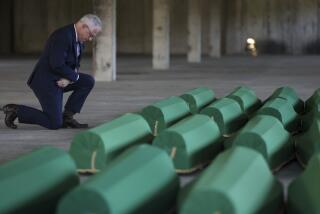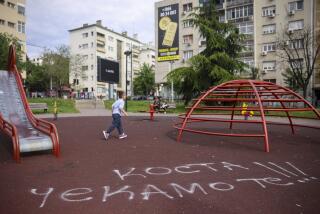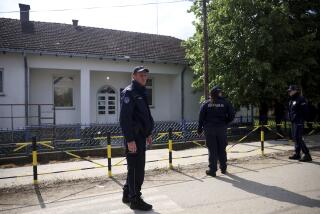Divided by warâs scars in Srebrenica
SREBRENICA, BOSNIA-HERZEGOVINA â The legacy of Radovan Karadzic is etched here in unsmiling, mistrustful faces; on tombstones that march shoulder to shoulder for nearly a quarter-mile; in empty, scarred houses whose owners never returned.
Karadzicâs Bosnian Serb army rounded up thousands of Muslims living or sheltering in Srebrenica on a sweltering July day 13 years ago and separated males from the women. Most of the more than 7,000 men and boys were killed, their bodies dumped in mass graves or scattered in the thickly forested hills.
Srebrenica stands as the deadliest atrocity in Europe since World War II, and is the single most egregious war crime for which Karadzic has been indicted by the international tribunal in The Hague. Arrested this week after more than a decade in hiding, he is expected to be sent to the court in the Netherlands within days.
Today, Srebrenica shows small signs of recovery. Though the town sits in the middle of Bosnian Serb territory, several thousand Muslims have returned; the mayor is a Muslim, as are other city officials. But the death and destruction allegedly wrought by Karadzicâs design left an enduring trauma.
As in much of Bosnia-Herzegovina, the prewar coexistence that Karadzic sought to wipe out has not been revived, and may never be.
âIâd say [Serbs and Muslims] are living parallel lives,â Mayor Abdurahman Malkic said Wednesday in an interview at City Hall. âMaybe one day we will be a mixed community again, but I think that would be in the very distant future, unfortunately.â
The capture of Karadzic, Malkic said, was bittersweet: excellent news that will âtake us closer to the truth and to justice,â but painfully long overdue.
Srebrenica operates under an unwritten code of ethnic politics and socialization. Muslim-owned coffee bars bear signs in green lettering over umbrellas advertising Sarajevo mineral water; the signage on Serb-owned businesses is more likely to be written in Cyrillic letters. Most (but not all) of the patronage is along ethnic lines.
Contact between Muslims and Serbs is largely superficial, the necessities of commerce, and there are no deep ties. Although there are no overt hostilities, several townspeople said, there is disdain.
âAs a Serb you cannot go to their cafes,â said Momir Djokanovic, 46, who was sitting with a rather forlorn group of Bosnian Serb pensioners having their morning coffee and brandy on the terrace of a community center.
âIt isnât anything they say, itâs their demeanor,â he said. âIf you ask a Muslim if we can ever live together again, they will say it can happen. If you ask a Serb, they will say it can never be.â
For Djokanovic and other Serbs here, the arrest of Karadzic was a demoralizing blow, a betrayal by Serbian authorities in Belgrade.
In Belgrade, more details emerged Wednesday of Karadzicâs public life on the lam. Disguised by a bushy white beard and long white hair, Karadzic -- calling himself Dragan âDavidâ Dabic and acting as a bohemian New Age healer -- frequented a bar in his suburban neighborhood of anonymous 1970s high-rise apartment buildings.
The tiny, cramped bar, called Crazy House, is decorated with pictures of Karadzic; his former army commander and fellow war crimes fugitive, Gen. Ratko Mladic; and their now-deceased paymaster, Slobodan Milosevic.
âDabicâ stopped by regularly, proprietor Misko Kovijanic told journalists. He would order sljivovica, the fiery plum brandy favored in this part of the world, and listen to nationalist songs routinely belted out by patrons. The songs were often accompanied by music from a gusle, a single-string lute-like instrument common in Karadzicâs native Montenegro.
At the next-door market, he was also a regular customer, purchasing yogurt, 5-liter bottles of water and a cheap red wine called Bearâs Blood.
It was also revealed that the name Karadzic was using belonged to a real person. B-92 TV reported that Dragan Dabic was born in Bosnia and died in Sarajevo in 1993. Karadzic was issued identity papers in Dabicâs name at a police station 25 miles outside Belgrade, B-92 said, suggesting a certain level of official complicity in his ruse.
Karadzicâs lawyer, Svetozar Vujacic, said Wednesday that his client would defend himself before the war crimes tribunal, much as Milosevic did before dying of a heart attack in custody in The Hague. Karadzic has gotten a haircut and shave and now looks like his former self, minus a few pounds, Vujacic said.
Vujacic said his client acknowledges that war crimes were committed but says he had nothing to do with them.
Karadzic never disputed having sent his army into Srebrenica. But he claimed the operation was designed to take control of an enclave that was being used as a staging ground for attacks on Serb civilians in other villages.
At the armyâs hands, the more than 7,000 men and boys were killed, women were raped and families were torn asunder. Srebrenica had been designated a âsafe havenâ under United Nations protection. But the Dutch troops posted there failed to stop the killings.
The bodies of about 3,500 victims of the massacre have been found, usually in hidden mass graves. Once identified, they are laid to rest in a sprawling memorial cemetery just outside Srebrenica. Row upon row of slender white-marble tombstones are engraved with names, date of death -- July 1995 -- and a Koranic verse.
Enver Sehmehmedovic, a 47-year-old metalworker living in the Netherlands since fleeing the 1992-95 war, was visiting the graveyard Wednesday with his two sons, ages 16 and 12.
âThis is a history lesson for them. . . . It is important to see the shame of a world that allowed this to happen,â he said. âWhen you come to the scene of the crime, the emotions of this truly terrible time come rushing back.â
Srebrenica has a bit of a ghost town feel to it. Its population is less than a third what it was before the war. On each steep, winding street, a few houses damaged in wartime shelling have been patched up, flowers planted, windows replaced. But others remain in ruins or abandoned.
After the Muslim civilians were taken away in 1995, Serbs who had been driven from their homes in other parts of Bosnia occupied Muslim homes in Srebrenica. Eventually, starting about 2000, Bosnian Serb authorities under pressure from international officials began evicting the Serbs so the original Muslim residents could come back.
Mujo Sirucic, 52, a fourth-generation resident of Srebrenica, returned in 1999 and over the next six years gradually brought back two grown children and his wife. A former electrical company manager, he hopes to open a business in an old stone cottage his family owns -- a Turkish-bath spa to take advantage of the local mineral springs.
Rather optimistically, he displays a copy of a new book titled âThe Tourist Potential of Srebrenica.â
âThe arrest of Karadzic as an individual is not the solution to the problem,â Sirucic said, sitting on colorful carpets covering the cottage floor and sipping Turkish coffee. âThe problem goes much deeper -- itâs the system he built.
âTo have a future, we are going to first have to deal with the past, which is like a sledgehammer killing us,â he added.
Twelve of Sirucicâs relatives are buried in the memorial cemetery, killed that summer 13 years ago; 15 others are missing. On his wall is a photograph from 1910 of his great-grandfather, a member of the local government, seated alongside other Muslim officials and the Serb mayor. The Muslims are wearing turbans and fezzes, the Serb a business suit.
Todayâs Srebrenica is very different. Segregation is not absolute, he said. âBut are there friendships where people spend time with each other, like before the war? No. Is there that mutual trust like before the war? There is none, and there will not be any time soon.â
--
More to Read
Sign up for Essential California
The most important California stories and recommendations in your inbox every morning.
You may occasionally receive promotional content from the Los Angeles Times.











